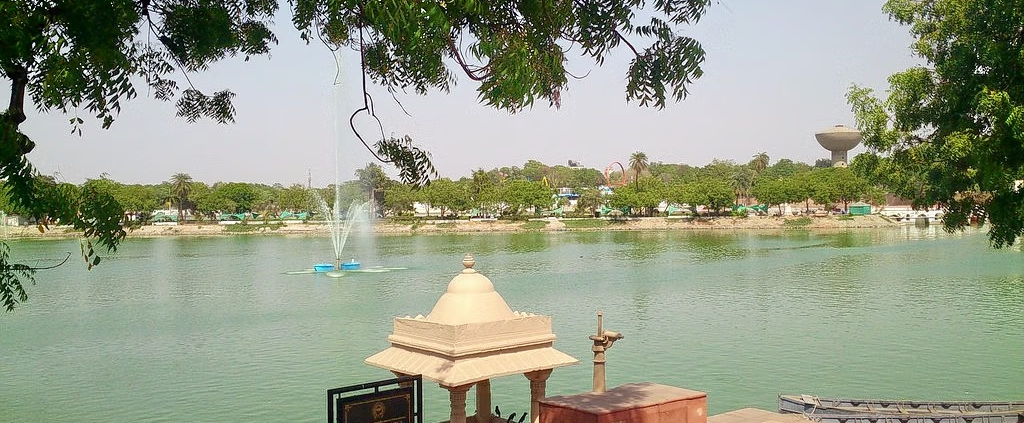What is the history of Nagina Wadi Ahmedabad?
Nagina Wadi, meaning “Jewel Garden,” is a historic and enchanting island garden that sits majestically in the middle of Kankaria Lake in Ahmedabad, Gujarat. Its story is deeply entwined with the origins of Kankaria Lake itself, a manmade lake with a heritage spanning over five centuries. The island garden has been a symbol of royal leisure, architectural beauty, and cultural significance throughout the city’s history.
Origins and Construction
The history of Nagina Wadi is inseparable from Kankaria Lake, which was constructed in the 15th century under the aegis of Sultan Qutb-ud-Din Ahmad Shah II of the Gujarat Sultanate. The lake was initially named “Hauj-e-Qutb,” or the Pond of Qutb, after the Sultan. According to inscriptions and chroniclers, the construction began under Sultan Muizz-ud-Din Muhammad Shah II and was completed during the reign of Sultan Qutb-ud-Din Ahmad Shah II in 1451 AD. The lake was created as a vast reservoir and a leisure ground to serve the rulers and the people of the city. The undertaking involved excavating earth to form embankments, creating a waterbody that covered approximately 76 acres in a unique 34-sided polygonal design.
At the center of this expansive artificial lake emerged an island garden called Bag-i-Nagina or Nagina Wadi, directly translating as the “Jewel Garden.” This garden was envisioned as a royal retreat, a serene place of tranquility amidst the bustling cityscape. The Sultan also ordered the construction of a pleasure palace or summer house on the island, making it a favored spot for the royal family to relax and enjoy the scenic beauty.
Architectural and Cultural Significance
Nagina Wadi represents an architectural marvel blending Mughal and Sultanate influences. The garden is connected to the lake’s edge by a picturesque bridge, originally crafted with 48 stone arches, some of which have been restored. The garden’s greenery, water features, fountains, and landscaped pathways create a harmonious and aesthetic space that has remained a cultural icon through the ages.
Historically, Nagina Wadi and Kankaria Lake were not only leisure destinations but also held social and cultural significance. The area was a favored spot for royals and citizens alike throughout the Gujarat Sultanate and later under Mughal rule. European travelers in the 17th century, such as Johan Albrecht de Mandelslo, documented their admiration for the gardens, describing them as charming and advantageously positioned for sweeping views of the surrounding landscape.
The garden also played a role in local cultural life with poets, artists, and musicians drawing inspiration from the tranquil waters and moonlit reflections. Over centuries, it witnessed phases of neglect, particularly after the decline of Mughal rule when the gardens and palace fell into disrepair under Maratha and early British administration.
Restoration and Modern Development
In the late 19th century, under British rule, the lake and Nagina Wadi experienced restoration efforts. The British collector of Ahmedabad oversaw improvements such as rebuilding embankments, restoring the pleasure house, cleaning ancient wells, and constructing parapet walls around the island. Although the original lake and garden structures showed signs of wear, restoration helped revive some of their former glory.
Fast forward to the 21st century, Nagina Wadi and Kankaria Lake underwent a major revitalization project led by the Ahmedabad Municipal Corporation, completed around 2008. This renovation aimed to transform the lakefront into a vibrant entertainment and recreational hub while preserving its historic and architectural essence. Nagina Wadi became the centerpiece of this rejuvenation, with enhancements like musical fountain shows, decorative lighting, lush landscaping, and walkways that welcome both locals and tourists alike.
Today, Nagina Wadi is more than a historic garden — it is a lively destination featuring attractions such as water sports, food stalls offering local delicacies, leisure areas ideal for family outings or romantic strolls, and the mesmerizing musical fountain show that synchronizes water, light, and music in an enchanting display after sunset.
Summary
Nagina Wadi, the jewel at the heart of Kankaria Lake, is a stunning example of Ahmedabad’s rich cultural and architectural heritage. Built in the 15th century as a royal pleasure garden by Sultan Qutb-ud-Din Ahmad Shah II, it has endured centuries of historical changes and restorations. Today, it stands as a modern recreational space retaining its historical charm, offering a serene yet vibrant experience to all who visit.
This floating garden not only reflects the grandeur of medieval Indian sultanates but also symbolizes the seamless blend of historical legacy and contemporary urban culture in Ahmedabad. Nagina Wadi remains a jewel, indeed — a shining gem resting serenely amidst the waters of Kankaria Lake.



Leave a Reply
Want to join the discussion?Feel free to contribute!